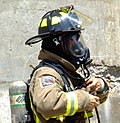Immediately dangerous to life or health
Immediately Dangerous to Life or Health (IDLH) is a term and concept used in the field of occupational health and safety to describe an environmental condition that poses an immediate or delayed threat to life, would cause irreversible adverse health effects, or would impair an individual's ability to escape from a dangerous situation. The National Institute for Occupational Safety and Health (NIOSH) is primarily responsible for establishing IDLH values for various substances and conditions.
Definition
The IDLH value is defined as the maximum level of a hazardous substance from which one could escape within 30 minutes without any escape-impairing symptoms or any irreversible health effects. This concept is crucial in the development of personal protective equipment (PPE) standards, the design of environmental monitoring in workplaces, and the establishment of emergency response procedures.
Criteria for Establishing IDLH Values
NIOSH considers several factors when determining the IDLH value for a substance or condition, including:
- Acute toxicity data from human and animal studies
- The concentration that could cause irreversible health effects
- The concentration that could impair the ability to escape
- Respiratory protection factors and limitations
Applications
IDLH values are used in various applications, including:
- Designing and selecting appropriate respiratory protection equipment
- Establishing safety protocols for handling hazardous materials
- Emergency response planning and training
- Risk assessment and management in workplaces
Examples
Some examples of IDLH values for common substances include:
- Carbon monoxide: 1200 parts per million (ppm)
- Hydrogen sulfide: 100 ppm
- Ammonia: 300 ppm
These values indicate the concentration levels above which immediate evacuation and the use of appropriate respiratory protection are necessary to prevent serious health effects or death.
Regulatory Aspects
In the United States, the Occupational Safety and Health Administration (OSHA) and NIOSH work together to regulate workplace exposure to hazardous substances. OSHA uses IDLH values to set requirements for respiratory protection programs under the Respiratory Protection Standard (29 CFR 1910.134).
Challenges and Considerations
Determining IDLH values involves uncertainties due to variations in individual susceptibility, exposure scenarios, and the quality of toxicity data. Therefore, these values are subject to revision as new information becomes available.
See Also
- Occupational Safety and Health Administration (OSHA)
- National Institute for Occupational Safety and Health (NIOSH)
- Personal Protective Equipment (PPE)
- Respiratory Protection
References
This safety related article is a stub. You can help WikiMD by expanding it.
Transform your life with W8MD's budget GLP-1 injections from $125.
W8MD offers a medical weight loss program to lose weight in Philadelphia. Our physician-supervised medical weight loss provides:
- Most insurances accepted or discounted self-pay rates. We will obtain insurance prior authorizations if needed.
- Generic GLP1 weight loss injections from $125 for the starting dose.
- Also offer prescription weight loss medications including Phentermine, Qsymia, Diethylpropion, Contrave etc.
NYC weight loss doctor appointments
Start your NYC weight loss journey today at our NYC medical weight loss and Philadelphia medical weight loss clinics.
- Call 718-946-5500 to lose weight in NYC or for medical weight loss in Philadelphia 215-676-2334.
- Tags:NYC medical weight loss, Philadelphia lose weight Zepbound NYC, Budget GLP1 weight loss injections, Wegovy Philadelphia, Wegovy NYC, Philadelphia medical weight loss, Brookly weight loss and Wegovy NYC
|
WikiMD's Wellness Encyclopedia |
| Let Food Be Thy Medicine Medicine Thy Food - Hippocrates |
Medical Disclaimer: WikiMD is not a substitute for professional medical advice. The information on WikiMD is provided as an information resource only, may be incorrect, outdated or misleading, and is not to be used or relied on for any diagnostic or treatment purposes. Please consult your health care provider before making any healthcare decisions or for guidance about a specific medical condition. WikiMD expressly disclaims responsibility, and shall have no liability, for any damages, loss, injury, or liability whatsoever suffered as a result of your reliance on the information contained in this site. By visiting this site you agree to the foregoing terms and conditions, which may from time to time be changed or supplemented by WikiMD. If you do not agree to the foregoing terms and conditions, you should not enter or use this site. See full disclaimer.
Credits:Most images are courtesy of Wikimedia commons, and templates, categories Wikipedia, licensed under CC BY SA or similar.
Contributors: Prab R. Tumpati, MD



